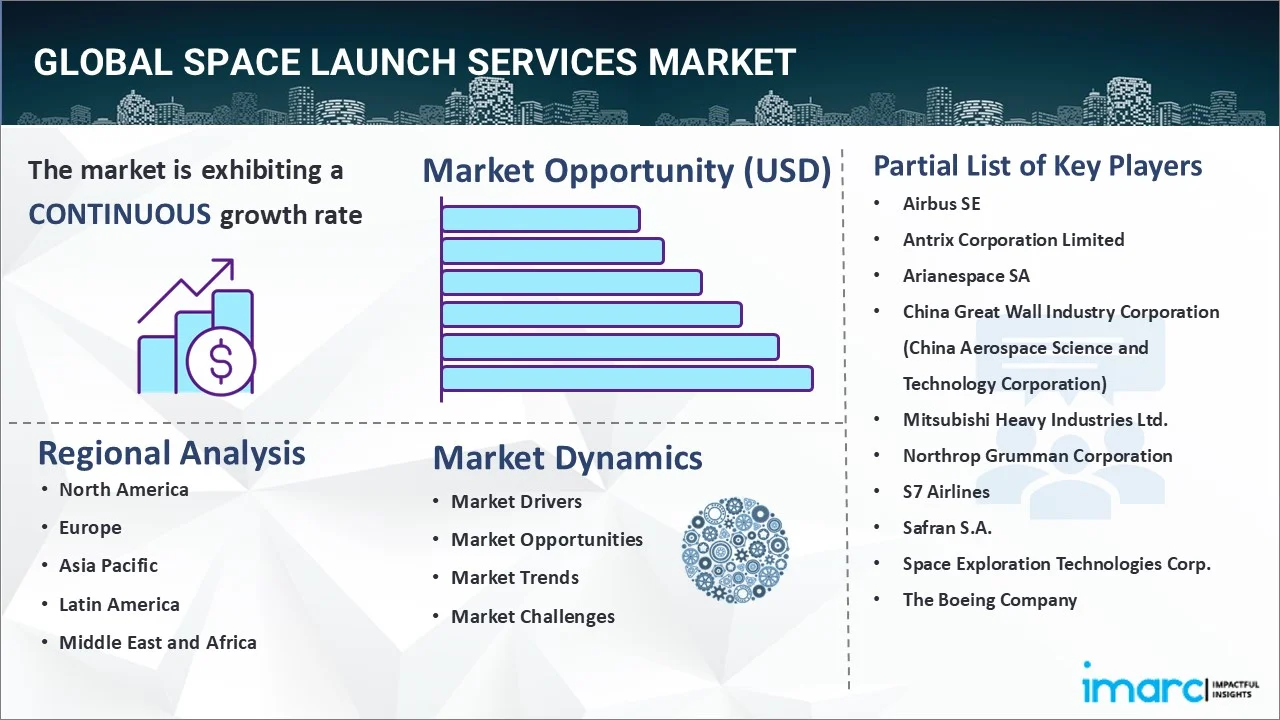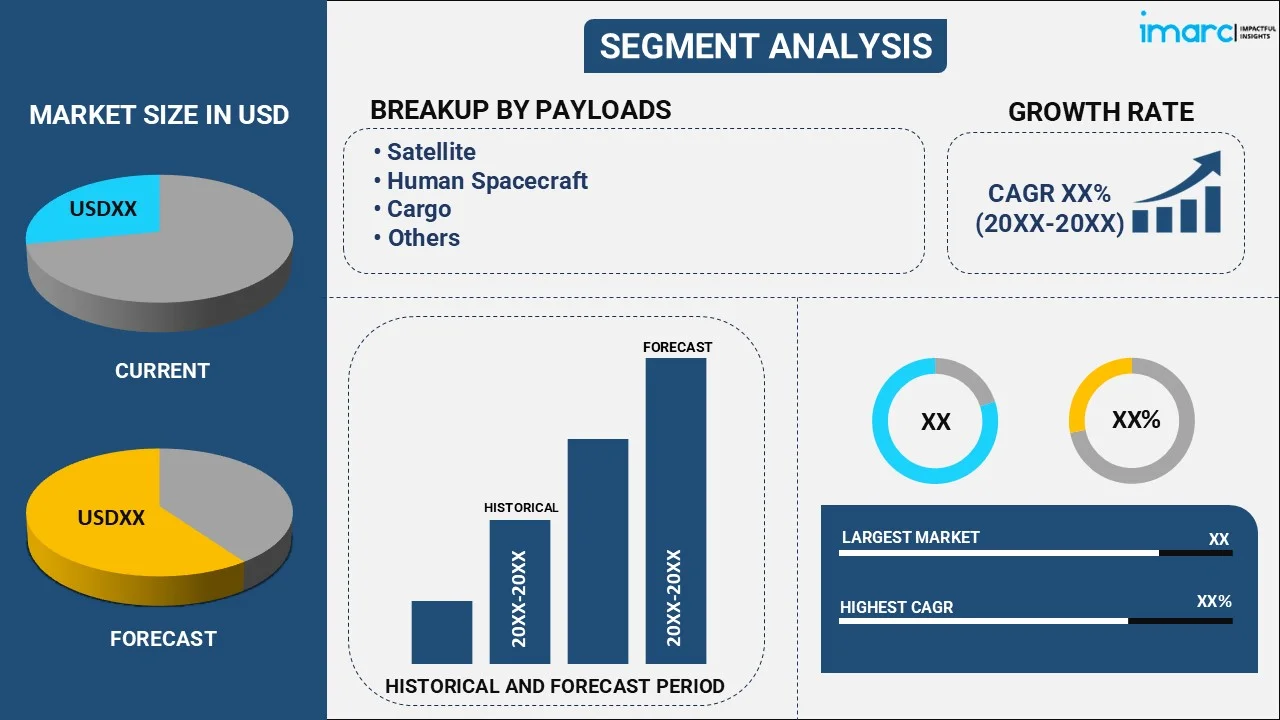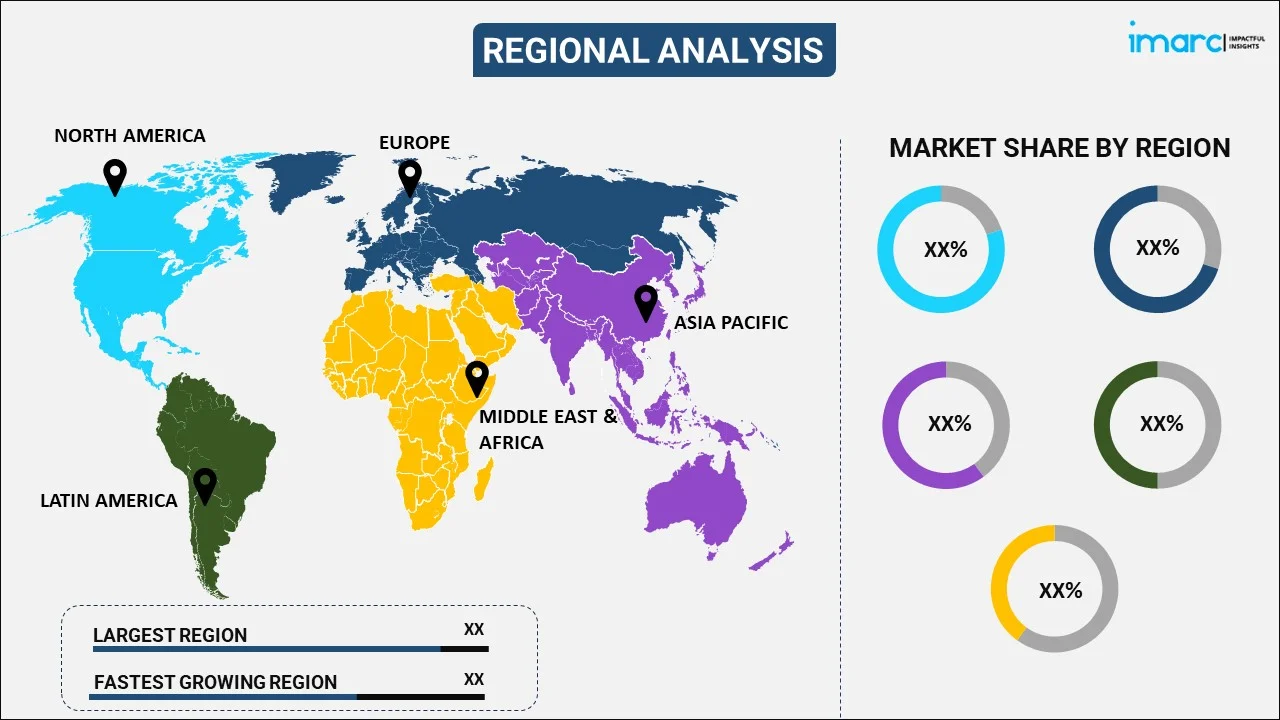
Space Launch Services Market Report by Payload (Satellite, Human Spacecraft, Cargo, Testing Probes, Stratollite), Launch Platform (Land, Air, Sea), Service Type (Pre-Launch, Post-Launch), Orbit (Low Earth Orbit (LEO), Medium Earth Orbit (MEO), Geosynchronous Orbit, Polar Orbit), Launch Vehicle (Small Launch Vehicle, Heavy Launch Vehicle), End User (Government and Military, Commercial), and Region 2025-2033
Market Overview:
The global space launch services market size reached USD 16.4 Billion in 2024. Looking forward, IMARC Group expects the market to reach USD 44.9 Billion by 2033, exhibiting a growth rate (CAGR) of 11.28% during 2025-2033. The market is experiencing significant growth mainly driven by the growing demand for satellite deployments and space exploration missions. North America currently holds the largest market share, supported by advanced infrastructure, strong government support, and increasing private sector involvement.
|
Report Attribute
|
Key Statistics
|
|---|---|
|
Base Year
|
2024
|
|
Forecast Years
|
2025-2033
|
|
Historical Years
|
2019-2024
|
|
Market Size in 2024
|
USD 16.4 Billion |
|
Market Forecast in 2033
|
USD 44.9 Billion |
| Market Growth Rate (2025-2033) | 11.28% |
Space launch, or lift-off, refers to the earliest part of the operations, wherein the rocket or other vehicles, including airborne aircraft and floating ship, are vertically released from the ground. This process involves a series of activities, such as ordering, conversing, stacking, assembling, and integrating payload for launching spacecraft, which in turn, assist in decreasing the set-in motion cost and promoting a smooth launch. On account of these properties, space launch services are extensively deployed by the government, space organizations, and military agencies for performing galaxy explorations. At present, these services are categorized into pre-launch and post-launch.

Space Launch Services Market Trends:
Commercialization and Increased Private Sector Involvement
Commercialization and increased private sector involvement are contributing positively to the space launch services market growth. Private launch providers are emerging as key players by offering competitive pricing and innovative technologies, making space access more affordable and efficient. This trend attracts substantial private investments and fosters the growth of startups, driving further innovation and expanding market capacity. Additionally, governments are increasingly forming public-private partnerships, collaborating with these private firms to utilize their expertise and agility. Emerging economies, such as India's space sector is undergoing privatization to enhance global competitiveness and leverage public-private partnerships. ISRO aims to increase its space economy from $9 billion to $44 billion through PPP. According to an article published in 2024, NewSpace India Limited is seeking partnerships with private entities for the production of ISRO's heavy lift launcher, the LVM3, to meet the rising global demand for communication satellites. Such collaborations help reduce costs, accelerate project timelines, and enhance the overall efficiency of space missions. Collectively, these dynamics are significantly increasing the space launch services market share, which, in turn, advances the capabilities and broadens the accessibility of space launch services.
Rising Focus on Reusable Launch Vehicles
Reusable launch vehicles are revolutionizing the space industry by significantly lowering the cost per launch. By refurbishing and relaunching rockets multiple times, the expenses associated with manufacturing new rockets for each mission are greatly reduced. This cost efficiency makes space access more affordable for a wider range of customers. For instance, in May 2024, Tokyo-based startup, Innovative Space Carrier Inc., announced its partnership with U.S. rocket engine maker, Ursa Major Technologies Inc., to develop a reusable satellite launch rocket, ASCA-1. The rocket, aiming for commercial use by 2030, will lower costs with its reusability. The Japanese company plans to operate a spacecraft capable of transporting around 50 people by the 2040s. Additionally, the ability to reuse rockets enables a higher frequency of launches, effectively meeting the increasing demand from satellite operators and other payload providers. According to the space launch services market analysis, the widespread adoption of reusable launch vehicles is projected to drive significant market growth. The enhanced reliability and reduced turnaround time of reusable vehicles ensure that launch schedules can be maintained more consistently, fostering growth and innovation in the space launch services market.
Regulatory Framework
Supportive regulatory frameworks are essential for the growth of the space launch services market. They provide well-defined guidelines and standards that help companies navigate legal requirements, ensuring compliance with safety, environmental, and international laws. Additionally, transparent regulations build trust and confidence among investors and stakeholders, attracting more players to enter the market. Supportive policies also encourage innovation by offering protections for intellectual property and facilitating collaboration, thereby fostering a competitive and dynamic industry environment. For instance, in March 2024, the Government of India amended FDI norms in the space sector to allow 100% overseas investment in satellite components, 74% in satellite manufacturing and operations, and 49% in launch vehicles. The move aims to attract foreign investment while considering security and strategic interests, which is expected to integrate India into the global supply chain and maintain control over satellite manufacturing and operations.
Key Market Segmentation:
IMARC Group provides an analysis of the key trends in each sub-segment of the global space launch services market report, along with forecasts at the global, regional and country level from 2025-2033. Our report has categorized the market based on payload, launch platform, service type, orbit, launch vehicle, and end user.
Breakup by Payload:

- Satellite
- Small Satellite (Less Than 1000 Kg)
- Large Satellite (Above 1000 Kg)
- Human Spacecraft
- Cargo
- Testing Probes
- Stratollite
Breakup by Launch Platform:
- Land
- Air
- Sea
Breakup by Service Type:
- Pre-Launch
- Post-Launch
Breakup by Orbit:
- Low Earth Orbit (LEO)
- Medium Earth Orbit (MEO)
- Geosynchronous Orbit
- Polar Orbit
Breakup by Launch Vehicle:
- Small Launch Vehicle
- Heavy Launch Vehicle
Breakup by End User:
- Government and Military
- Commercial
Breakup by Region:

- North America
- United States
- Canada
- Asia-Pacific
- China
- Japan
- India
- South Korea
- Australia
- Indonesia
- Others
- Europe
- Germany
- France
- United Kingdom
- Italy
- Spain
- Russia
- Others
- Latin America
- Brazil
- Mexico
- Others
- Middle East and Africa
Competitive Landscape:
The report has also provided a comprehensive analysis of the competitive landscape in the global space launch services market. Detailed profiles of all major companies have also been provided. Some of the companies covered include:
- Airbus SE
- Antrix Corporation Limited
- Arianespace SA
- China Great Wall Industry Corporation (China Aerospace Science and Technology Corporation)
- Mitsubishi Heavy Industries Ltd.
- Northrop Grumman Corporation
- S7 Airlines
- Safran S.A.
- Space Exploration Technologies Corp.
- The Boeing Company
Kindly note that this only represents a partial list of companies, and the complete list has been provided in the report.
Space Launch Services Market News:
- In October 2024, Maritime Launch Services Ltd. (Maritime Launch) and Reaction Dynamics (RDX) announced their partnership to advance Canadian orbital launch capabilities. This collaboration aims to conduct Canada's first-ever orbital launch of a domestically developed rocket from Nova Scotia's coast. The companies plan to start with a pathfinder mission and then move on to commercial missions using RDX's advanced hybrid rocket technology.
- In October 2024, the UAE Space Agency partnered with Mitsubishi Heavy Industries for the launch of the "Emirates Mission to the Asteroid Belt" using the H3 launch vehicle in 2028. This agreement marks their third collaboration, following the successful launches of KhalifaSat and the Emirates Mars Mission.
- In October 2024, Rocket Lab USA, Inc. (Nasdaq: RKLB) (“Rocket Lab” or “the Company”), a global leader in launch services and space systems, announced that it has added a last-minute Electron launch to its launch manifest for a commercial mission that is scheduled to launch in the upcoming days. he introduction of this latest mission to Electron’s 2024 launch manifest, less than two months since the launch contract was signed, represents Rocket Lab’s fastest contract-to-launch turnaround ever.
Space Launch Services Market Report Scope:
| Report Features | Details |
|---|---|
| Base Year of the Analysis | 2024 |
| Historical Period | 2019-2024 |
| Forecast Period | 2025-2033 |
| Units | Billion USD |
| Segment Coverage | Payload, Launch Platform, Service Type, Orbit, Launch Vehicle, End User, Region |
| Region Covered | Asia Pacific, Europe, North America, Latin America, Middle East and Africa |
| Countries Covered | United States, Canada, Germany, France, United Kingdom, Italy, Spain, Russia, China, Japan, India, South Korea, Australia, Indonesia, Brazil, Mexico |
| Companies Covered | Airbus SE, Antrix Corporation Limited, Arianespace SA, China Great Wall Industry Corporation (China Aerospace Science and Technology Corporation), Mitsubishi Heavy Industries Ltd., Northrop Grumman Corporation, S7 Airlines, Safran S.A., Space Exploration Technologies Corp. and The Boeing Company |
| Customization Scope | 10% Free Customization |
| Post-Sale Analyst Support | 10-12 Weeks |
| Delivery Format | PDF and Excel through Email (We can also provide the editable version of the report in PPT/Word format on special request) |
Key Questions Answered in This Report
The global space launch services market was valued at USD 16.4 Billion in 2024.
We expect the global space launch services market to exhibit a CAGR of 11.28% during 2025-2033.
The sudden outbreak of the COVID-19 pandemic had led to the implementation of stringent lockdown regulations across several nations resulting in the decline of space-related activities and delay in the space launches, thereby negatively impacting global market for space launch services.
The rising adoption of space launch services across the commercial, government, and military and defense sectors, owing to the increasing number of aircraft and satellite testing during launches, is primarily driving the global space launch services market.
Based on the payload, the global space launch services market has been bifurcated into satellite, human spacecraft, cargo, testing probes, and stratollite. Among these, satellite currently exhibits a clear dominance in the market.
Based on the launch platform, the global space launch services market can be segmented into land, air, and sea. Currently, land holds the majority of the total market share.
Based on the service type, the global space launch services market has been divided into pre-launch and post-launch, where pre-launch currently exhibits a clear dominance in the market.
Based on the orbit, the global space launch services market can be categorized into Low Earth Orbit (LEO), Medium Earth Orbit (MEO), geosynchronous orbit, and polar orbit. Currently, Low Earth Orbit (LEO) accounts for the majority of the global market share.
Based on the launch vehicle, the global space launch services market has been segregated into small launch vehicle and heavy launch vehicle, where heavy launch vehicle currently holds the largest market share.
Based on the end user, the global space launch services market can be bifurcated into government and military and commercial. Currently, the government and military sector exhibits a clear dominance in the market.
On a regional level, the market has been classified into North America, Asia-Pacific, Europe, Latin America, and Middle East and Africa, where North America currently dominates the global market.
Some of the major players in the global space launch services market include Airbus SE, Antrix Corporation Limited, Arianespace SA, China Great Wall Industry Corporation (China Aerospace Science and Technology Corporation), Mitsubishi Heavy Industries Ltd., Northrop Grumman Corporation, S7 Airlines, Safran S.A., Space Exploration Technologies Corp., and The Boeing Company.
Need more help?
- Speak to our experienced analysts for insights on the current market scenarios.
- Include additional segments and countries to customize the report as per your requirement.
- Gain an unparalleled competitive advantage in your domain by understanding how to utilize the report and positively impacting your operations and revenue.
- For further assistance, please connect with our analysts.

 Inquire Before Buying
Inquire Before Buying
 Speak to an Analyst
Speak to an Analyst
 Request Brochure
Request Brochure
 Request Customization
Request Customization



.webp)




.webp)












